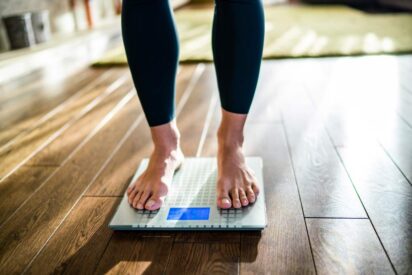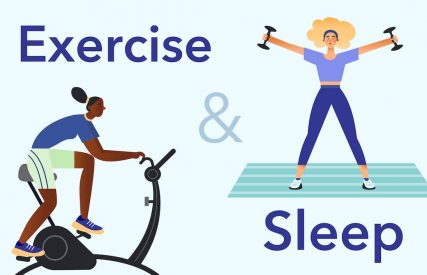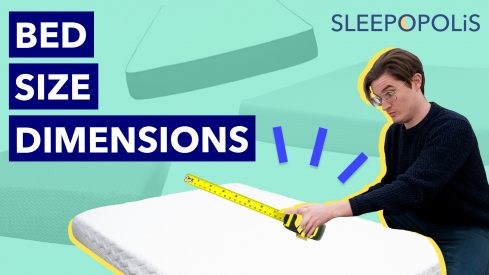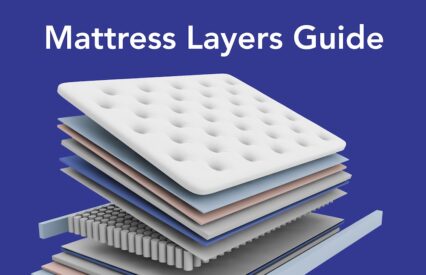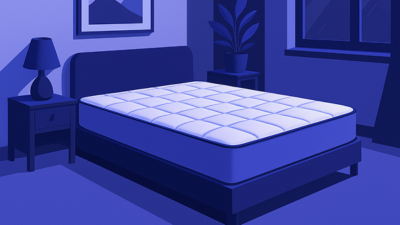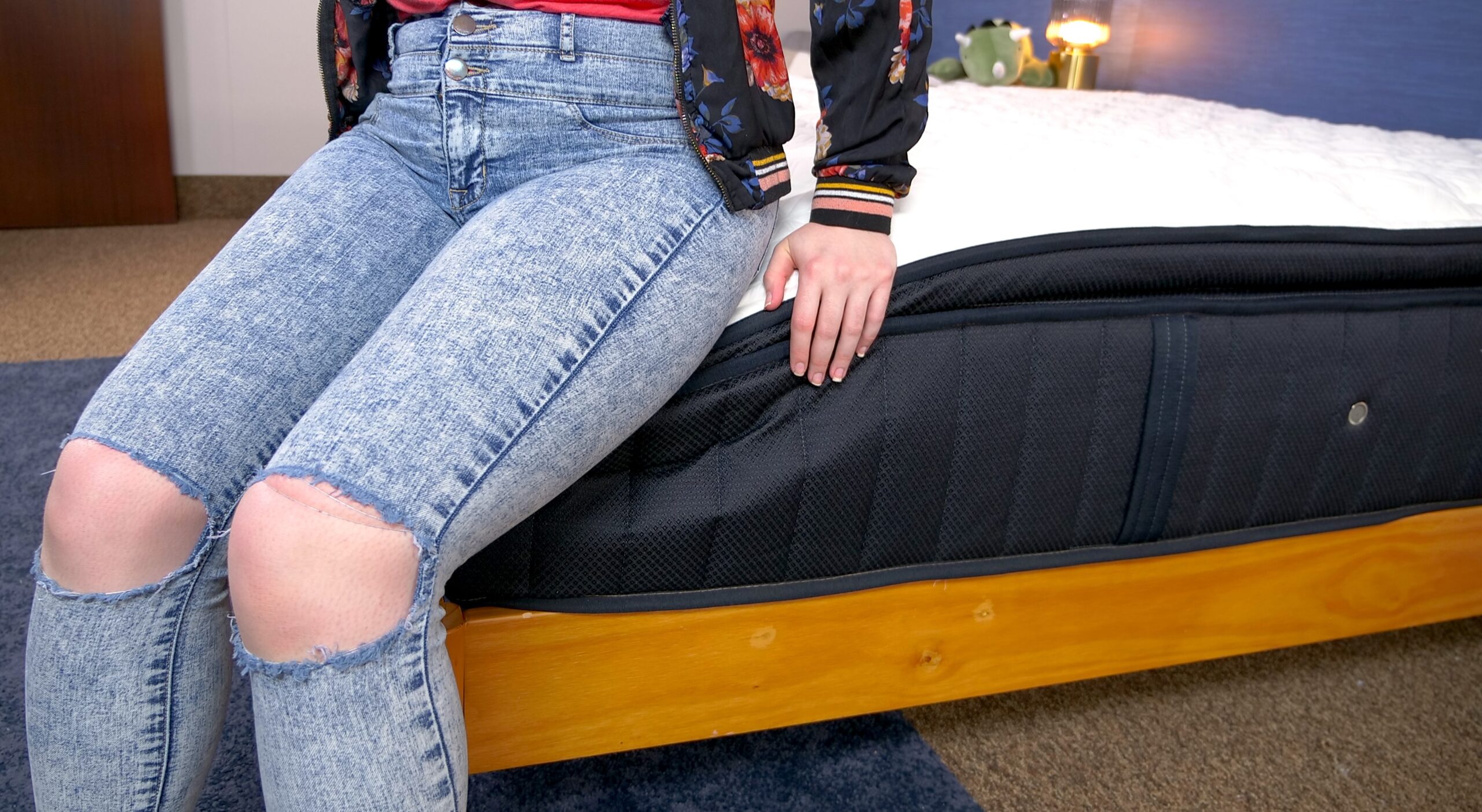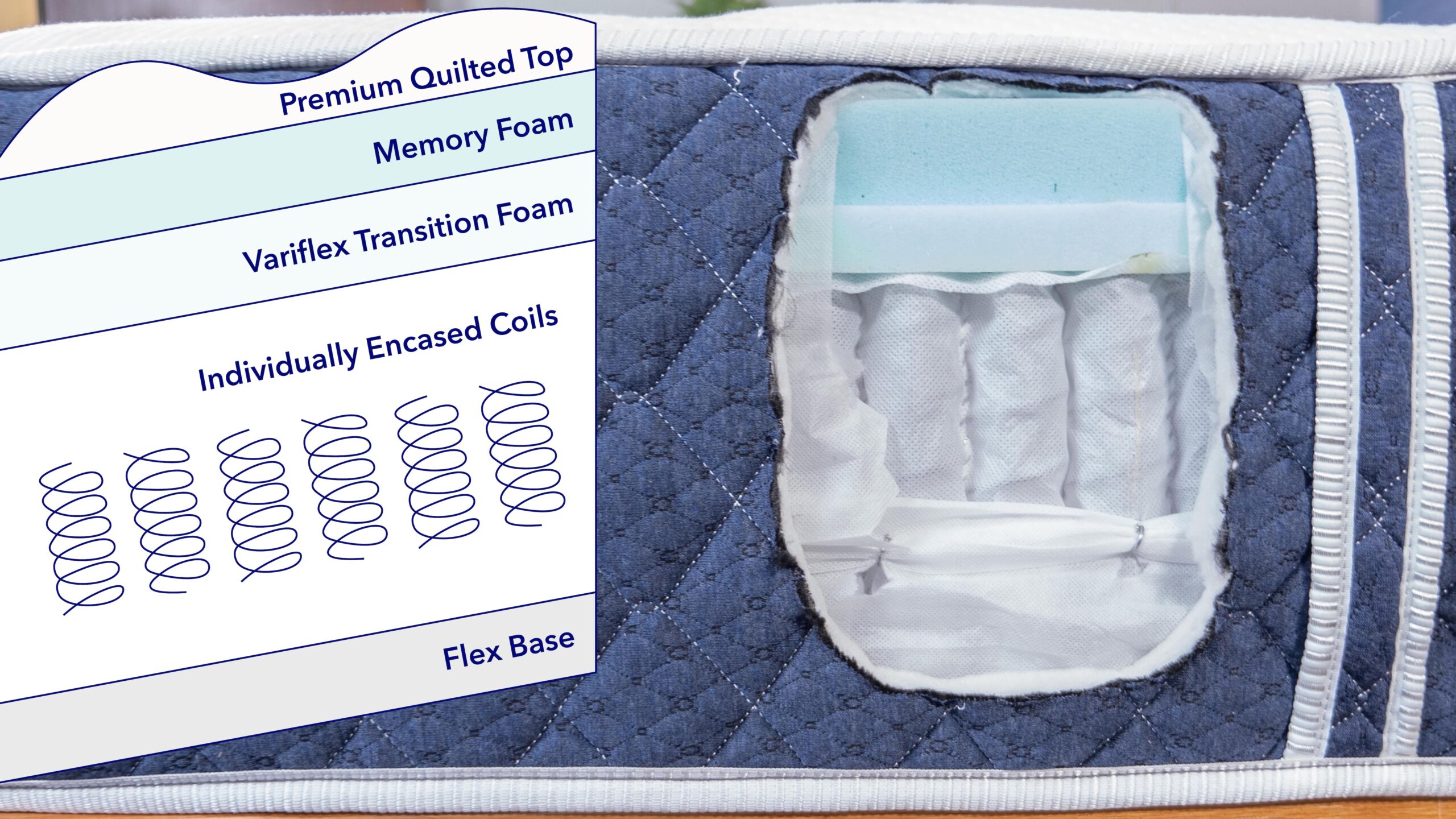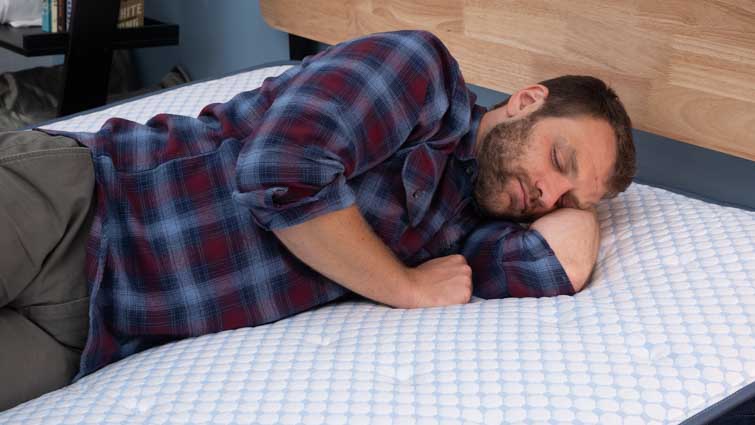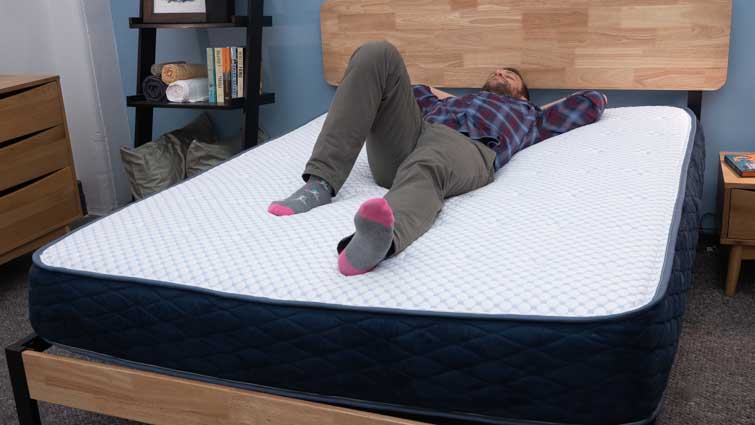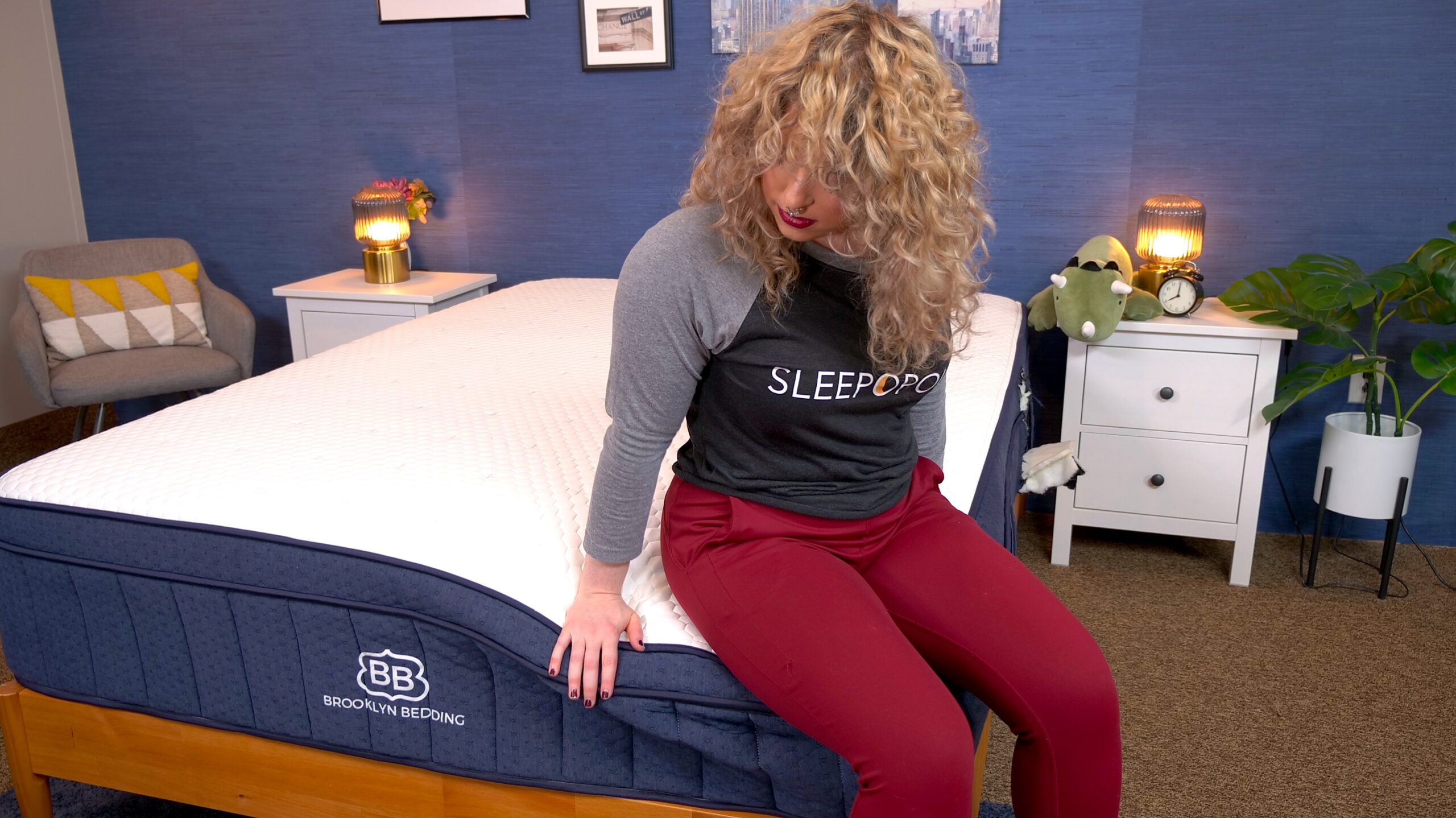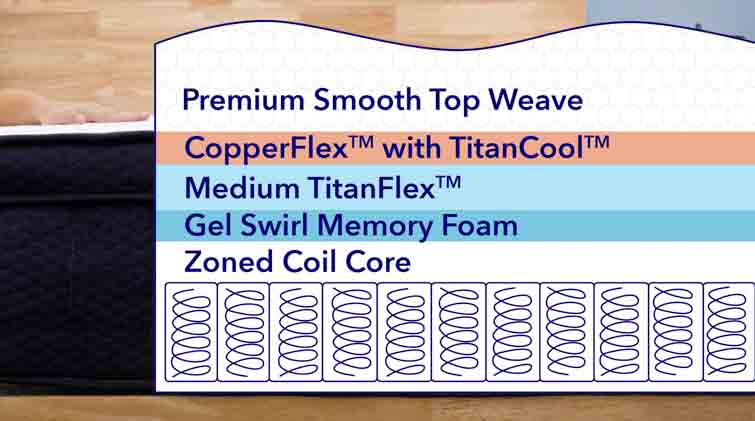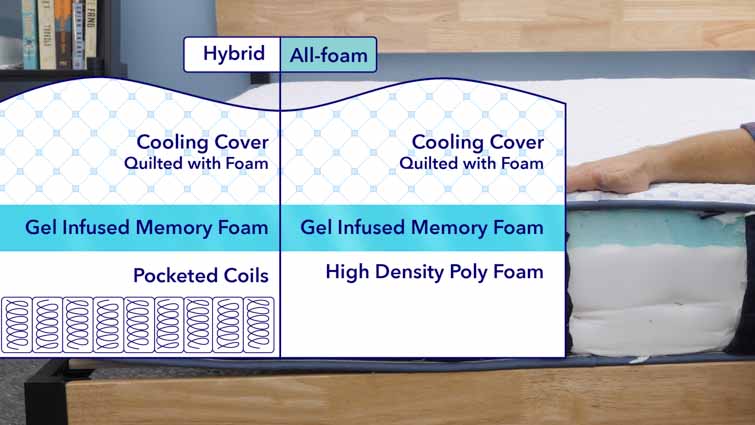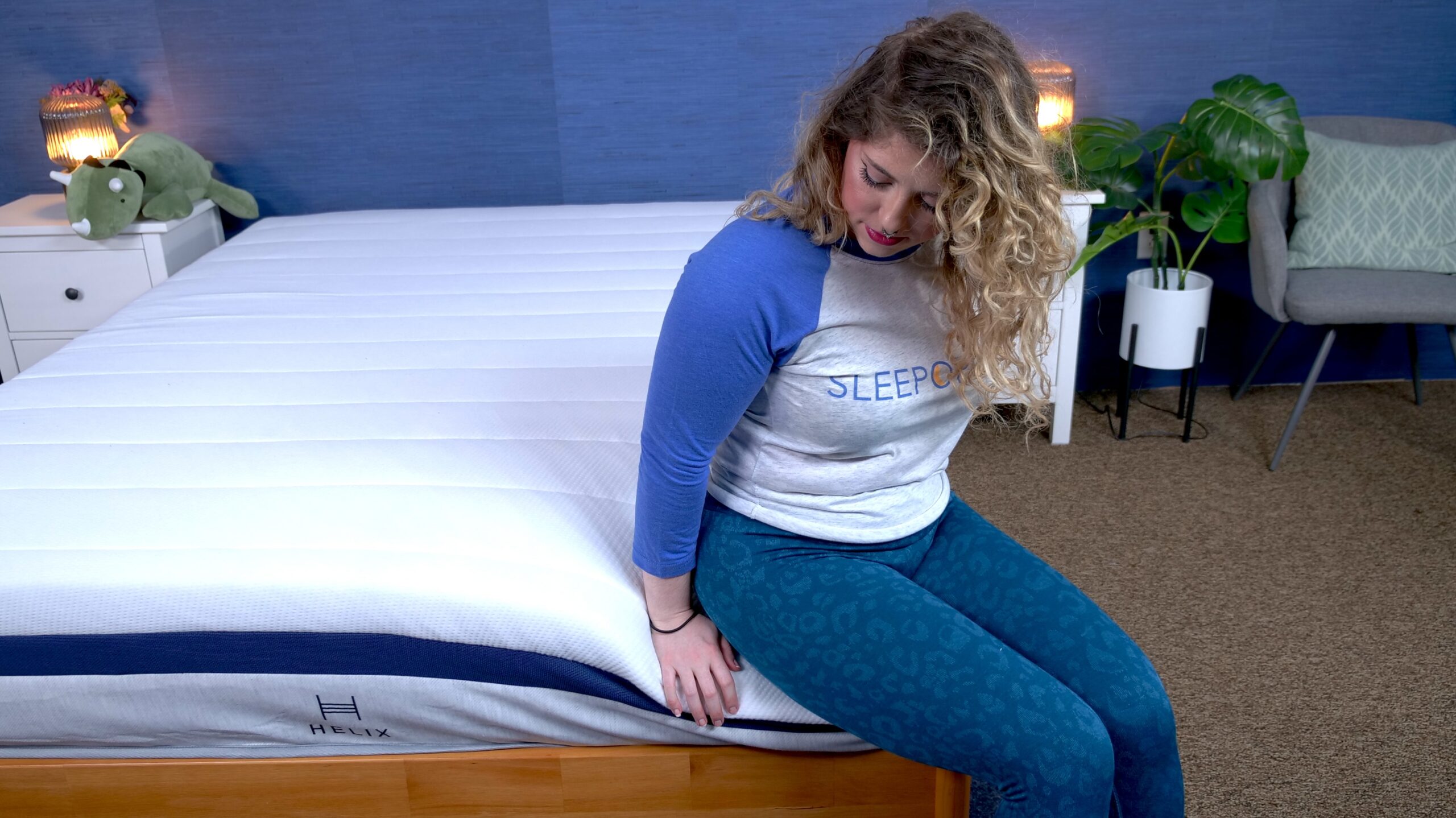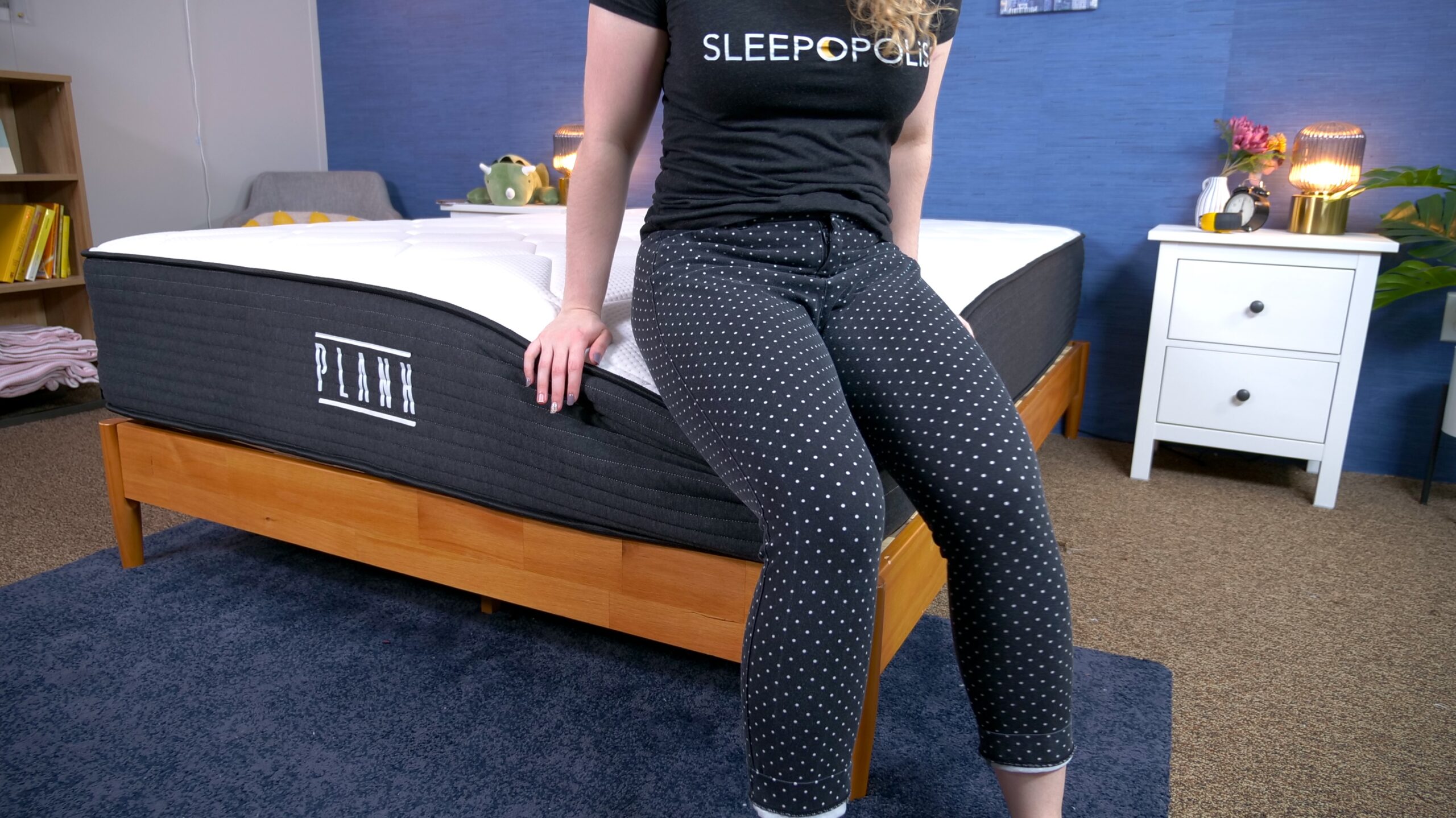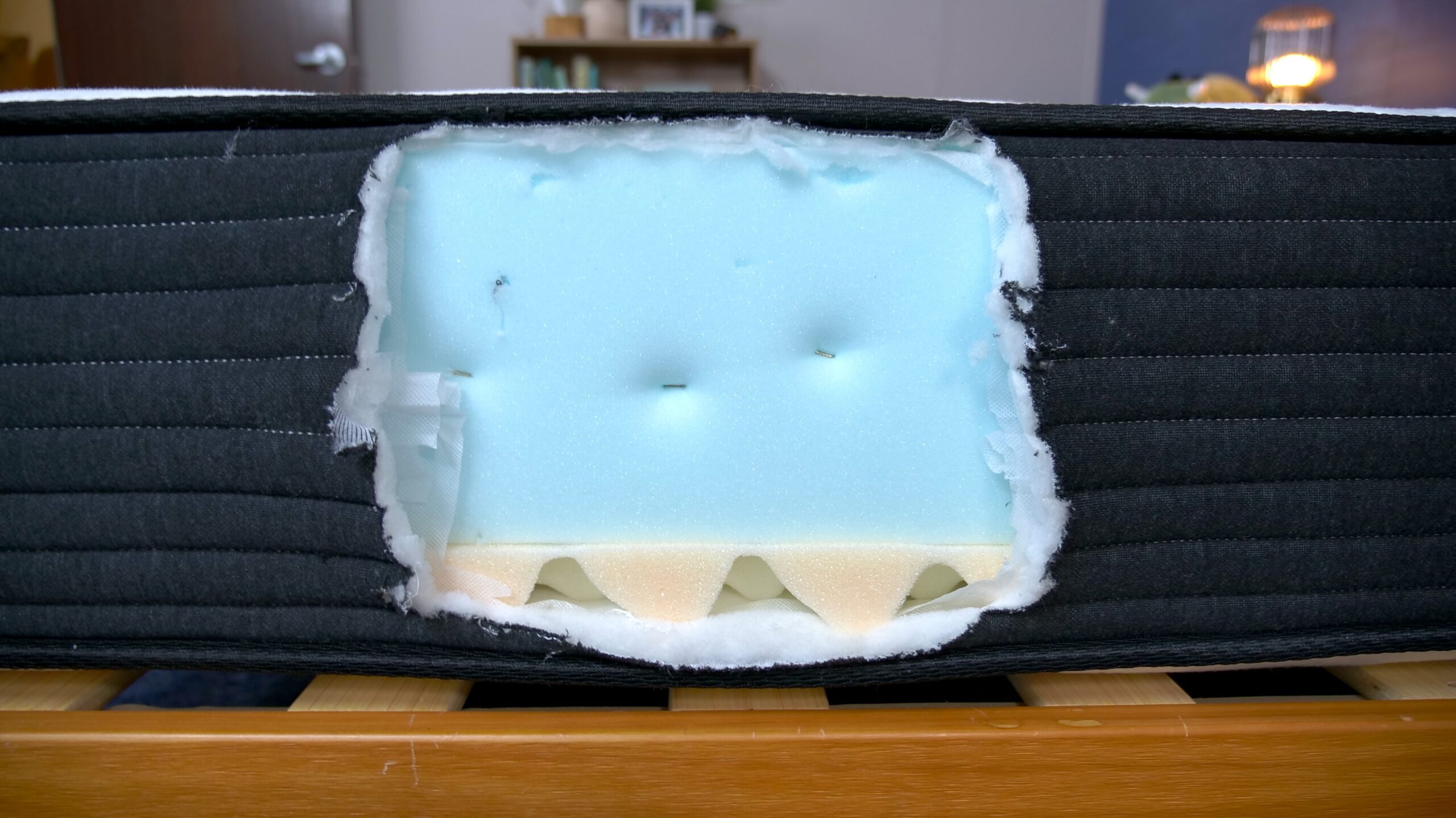Sleeping while traveling once meant tent camping, staying in a trailer, or checking into a hotel, but with the rise of the recreational vehicle (RV), hitting the road no longer means sacrificing comfort. Millions of Americans now enjoy the freedom of RV travel and the ability to sleep in a cozy bed no matter where they go. Many modern RVs offer features like plush interiors and modern amenities that make sleeping on the road as comfortable as sleeping at home.
However, it’s important not to skimp out on sleep when you’re on the road. The right RV mattress is essential to ensure that your body gets the support it needs, especially if you’re traveling frequently or using your RV as a home base. As Dr. Raj Dasgupta, Chief Medical Advisor at Sleepopolis, explains:
“Using the wrong mattress can worsen or cause back pain by disrupting spinal alignment, creating pressure points, and leading to discomfort. An unsuitable mattress may lack proper support, have an uneven surface, or not match your preferred sleeping position. Over time, material degradation and inadequate size can also contribute to back pain.”
If it’s time to upgrade or replace the mattress in your RV, choosing one that allows you to get a restful night’s sleep is crucial. In 2024, Sleepopolis helped 12,544 people choose a new bed, and in this guide, I’ll walk you through some of the best RV mattresses so you can rest easy no matter where the road takes you.
Our Top Pick for RV Mattresses
The Brooklyn Bedding Signature Hybrid earned our top spot on the Best RV mattress page because it’s not only a comfortable bed to rest on after a long day of adventuring, but it’s also incredibly supportive. It’s a well-rounded option that promotes a balanced feel, so our testers love this bed for a variety of different sleepers and circumstances.
Best RV Mattresses 2025
- Best Overall – Brooklyn Bedding Signature Hybrid
- Best Value RV Mattress – Dreamfoam Essential
- Best Luxury RV Mattress – Brooklyn Bedding Aurora Luxe
- Best Hybrid RV Mattress – Dreamfoam Hybrid
- Best Cooling RV Mattress – Helix Midnight
- Best Firm RV Mattress – Plank Firm
Comparing the Best RV Mattresses
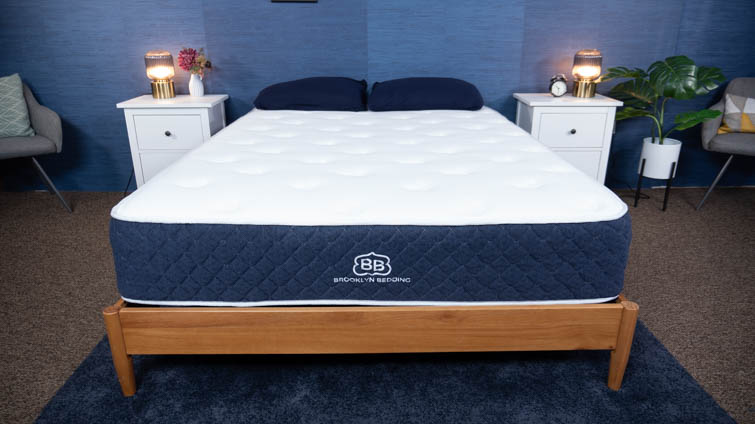
|

|
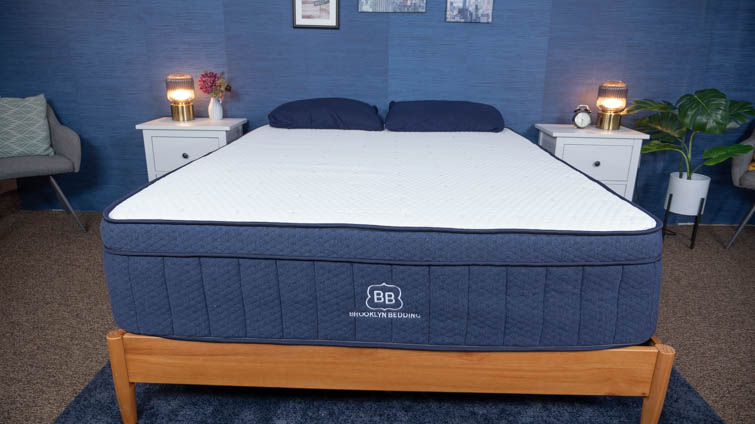
|
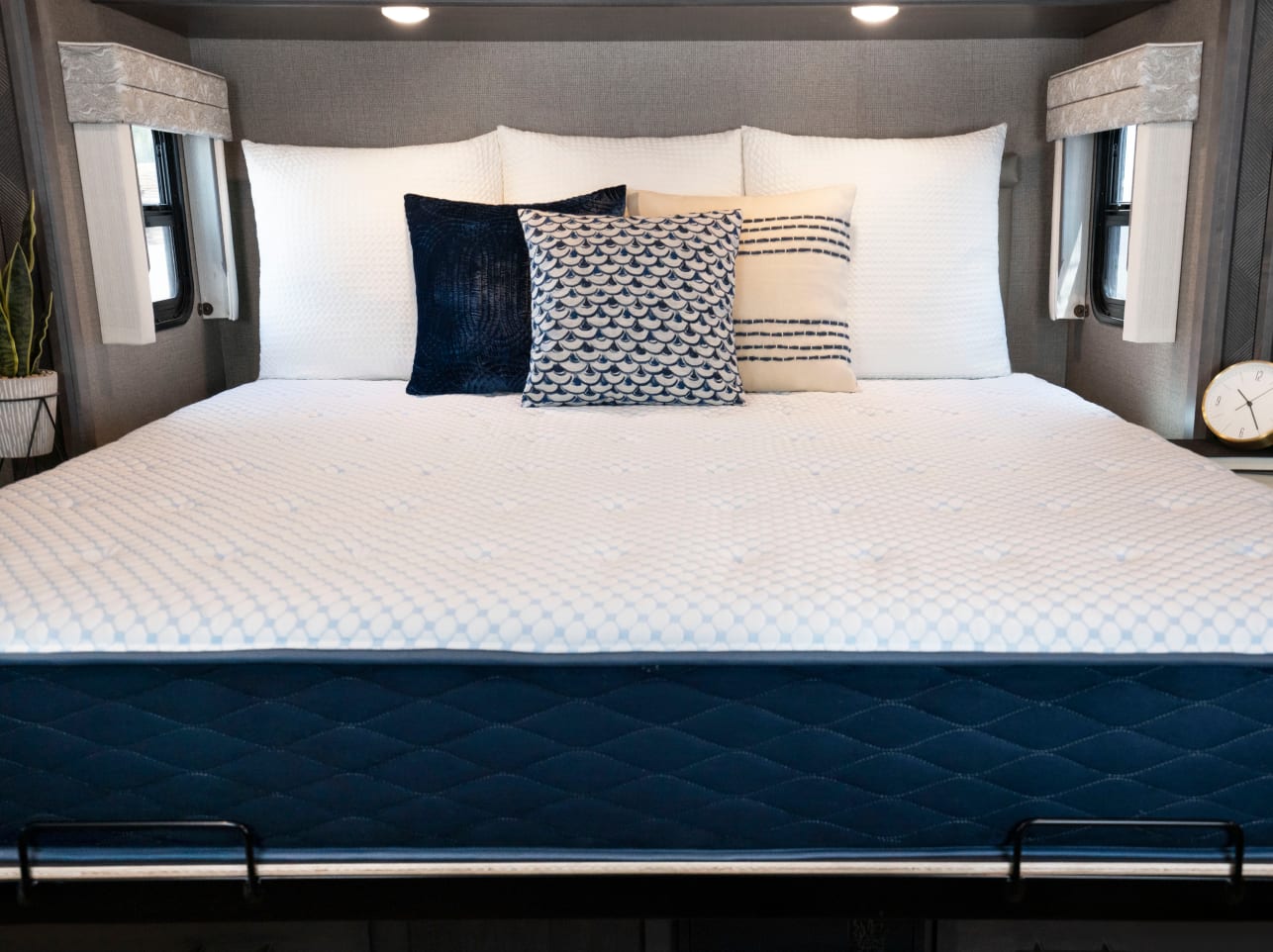
|
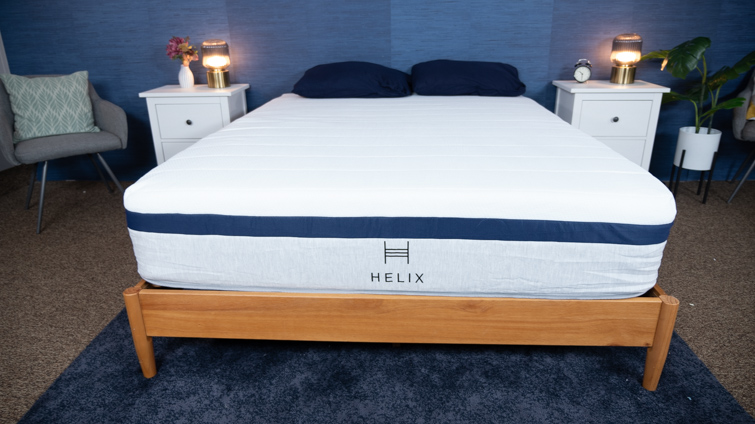
|
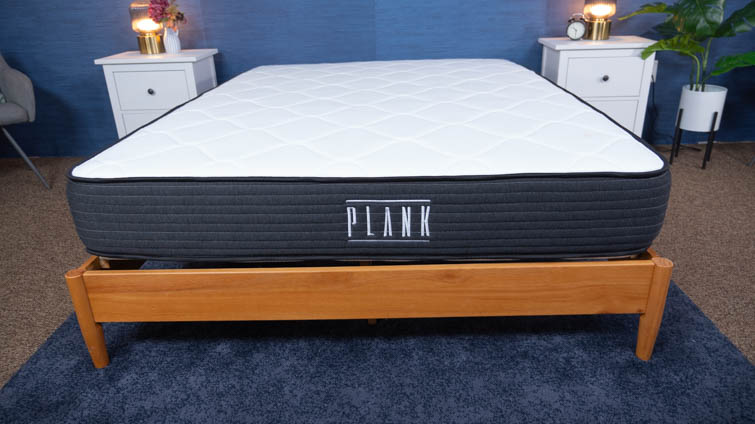
|
|
| Brooklyn Bedding Signature Hybrid RV Mattress | Dreamfoam Essential RV Mattress | Brooklyn Bedding Aurora Luxe RV Mattress | Dreamfoam Hybrid RV | Helix Midnight Mattress | Brooklyn Bedding Plank Firm Mattress | |
| Rating | ||||||
| Firmness | Multiple firmness options | Firm: 7.5/10 | Multiple firmness options | Medium-firm: 6.5/10 | Medium-firm: 6.5/10 | Multiple firmness options |
| Material | Hybrid | Foam | Hybrid | Hybrid | Hybrid | Foam |
| Cooling | — | — | — | — | — | |
| Best For |
Back Sleepers,
Seniors, Couples |
Side Sleepers,
Back Sleepers |
Side Sleepers, Hot Sleepers, Back Pain, Hip Pain,
|
Back Sleepers,
|
Side Sleepers,
Back Sleepers, Couples |
Back Sleepers, Stomach Sleepers, Back Pain, Seniors,
|
What We Look For In The Best RV Mattress
Durability
When looking for the best RV mattress, one thing we are looking out for is durability. You want to be sure your mattress can survive camping trips, road trips, and everything in between. We tested each of these mattresses for their durability by examining the quality of their materials and their construction. To help their durability scores, we also checked out their warranty policies to help you find the most durable RV mattresses.
Temperature Regulation
When you are spending the night in your RV, you want to make sure you are staying cool, and we want to help you do that, so we tested the cooling properties of each of these beds. To do so we first considered the materials they are made of and checked for cooling foams or breathability. We then used a thermal gun to test the change in temperature of the mattress after five minutes of laying on it to help you find a cooling and regulated RV mattress.
Comfort
If you are opting for an RV over traditional methods of camping, we know comfort is important to you. It is important to us too, so we made sure to examine the comfort of each of these mattresses by testing them out ourselves and laying on them in various sleeping positions. We also looked out for various types of mattresses, like foam and hybrid, to help you find the most comfortable mattress for you. We also tested each against our firmness scale, which ranks mattresses from 1-10, with 10 being the most firm, to help you find = your perfect RV mattress.
Best Overall – Brooklyn Bedding Signature Hybrid
The Brooklyn Bedding Signature Hybrid mattress combines a foam comfort layer and sturdy coils. This combination of materials makes it bouncy and easy to move around on. It comes in three firmness levels, and we recommend the Medium model for most back sleepers. It’s a great choice for shoppers who are looking for a new mattress on a budget. For more information, check out our video review.
What our tester says:
“Given that the Signature Hybrid has some excellent bounce, I’d highly recommend this mattress for combination sleepers who often change positions multiple times throughout the night. I also think the Signature Hybrid could be a great fit for couples. You shouldn’t be overly disturbed by a restless partner on this bed, and it has nice, firm edge support.” – Nichole Mondshein, lead reviewer and staff writer
Expert Opinion
Available in several unique sizes to accommodate vehicles, the Brooklyn Bedding Signature Hybrid is perhaps Brooklyn Bedding’s most popular model. When analyzing this mattress’s construction, our testers found five distinct layers, from a quilted cover and cushioning memory foam to sturdy individually wrapped coils. This resulted in an extremely balanced feel, which we put at a 6.5 out of 10 on our firmness scale. Keep in mind that this was for the Signature Hybrid’s Medium version. And when you’re selecting your own RV mattress, you can choose between three different firmness options depending on your body type and overall preferences.
To ensure we provided an accurate recommendation of who the Signature Hybrid is best for, we put its Medium model through our pressure map test, which uses thermal imaging to determine areas of high, moderate, and low pressure. While back sleeping, we saw almost no pressure buildup, making it an excellent option for back sleepers who need contouring at the lumbar region. And for side sleeping, we had some good results as well, but we did see some pressure buildup, so it’s not the best for those with shoulder and/or hip pain. For more plushness, we recommend the Soft model. For stomach sleepers out there, we recommend the Firm model.
Best Value RV Mattress – Dreamfoam Essential
The Dreamfoam Essential is a high-quality budget option, with enough firmness levels, height options, and price points to suit a wide variety of sleepers. We think RV-specific sizes make it especially good for travelers. Learn more in our Dreamfoam Essential video review.
What our tester says:
“When I was on my back my weight felt evenly distributed. I sunk into the memory foam comfort layer just a touch and enjoyed some body-contouring, while the firmer support layer ensured my hips stayed elevated and aligned with my spine.” – Logan Block, former Sleepopolis director of content and mattress tester
Expert Opinion
The Dreamfoam Essential is Brooklyn Bedding’s very first mattress, and definitely one of it’s most budget-friendly models. Traveling can quickly become expensive, but RV-goers should fall in love with the Essential’s price. For a twin, the Essential is $274 before discounts. For a queen, it’s $524 before discounts. Most mattresses out there cost anywhere from $1,000–$2,000, sometimes even more. And while the Essential isn’t the most durable, high-quality option out there, our testers felt it was a fantastic mattress for the price and thus deserving of its place as the best value RV mattress.
To determine if the Dreamfoam Essential is truly a quality mattress with consideration for its price, we did what we do with all of the mattresses that come into our studio: put them through a large series of tests. We cut open the side of the Essential mattress to reveal its construction, and found that it’s made entirely of foam. We were surprised to find top comfort layer of cooling gel memory foam, since extra features aren’t typically present in such low-cost beds. For support, there’s a super thick layer of high-density poly foam. And at the top of the mattress, there’s a cover with a Nano Stain Terminator finish, which should make for easy cleanup whenever there’s a spill on the road.
Best Luxury RV Mattress – Brooklyn Bedding Aurora Luxe
The Brookyn Bedding Aurora Luxe mattress is one of Brooklyn Bedding’s more high-end mattresses. It’s got a ton of cooling features in it that can help hot sleepers sleep cool all night. It’s also available in three different firmnesses, so it can accommodate all of the sleeping positions. For more information, check out our video review.
What our tester says:
“First and foremost, I’d recommend this mattress to hot sleepers. This bed sleeps nice and cool thanks to special phase change technology and gel infusions. The Aurora Luxe is also a nice pick for back sleepers. This mattress in the Medium model is medium-soft, so it should contour the hips while also lifting them into alignment.” – Nichole Mondshein, lead reviewer and staff writer
Expert Opinion
Just because you can’t fit a king size bed in your RV doesn’t mean you have to sacrifice luxury. That’s where the Brooklyn Bedding Aurora Luxe comes in; it’s a hybrid mattress with several luxurious features and multiple firmness options. Its premium cooling cover provides a plush and cool-to-the-touch feel, its special cooling memory foam comfort layer gives pressure relief, and its coils increase the bed’s overall support.
When we tested out this luxury hybrid, we felt like we were sleeping on the type of mattress you’d find in a high-end hotel. On their website, Brooklyn Bedding does offer sizes specifically for an RV. The Aurora Luxe comes in an RV King (72″ x 80″) and an RV Bunk (42″ x 80″).
Best Hybrid RV Mattress – Dreamfoam Hybrid
The Dreamfoam Hybrid is a high-quality budget option that includes cooling technology great for hot sleepers. We think RV-specific sizes make it especially good for travelers. Learn more in our Dreamfoam Hybrid video review.
What our tester says:
“Side sleepers who switch between their back and side should be happy here, but strict side sleepers will likely find their hips and shoulders sinking too far into this bed.” – Logan Block, former Sleepopolis director of content and mattress tester
Expert Opinion
Not everyone is partial to a slow-sinking memory foam feel. Some folks like a balance between plush foams and sturdy coils. If you’re one of those people, we can’t recommend the Dreamfoam Hybrid enough. It has a simple construction: a quilted cooling cover, gel-infused memory foam, and a layer of support coils. This gives it an overall balanced feel that should appeal greatly to many back sleepers and some side sleepers who like a firmer feel. RV users can choose between standard size options as well as an RV bunk size and two variations of an RV king.
While testing the Dreamfoam Hybrid bed, we found that true to the hybrid stereotype, it offers some great cooling. Each of its three layers incorporate cooling properties, from its cooling cover, cooling gel-infused memory foam, and breathable coils.
Best Cooling RV Mattress – Helix Midnight
The Helix Midnight is amongst Helix’s line of six standard mattresses. It’s known for its more balanced feel, allowing it to accommodate a wide range of sleepers. We also recommend it for couples, as it scored well on our motion isolation, responsiveness, edge support, and cooling tests. For a plusher and more cooling version of this mattress, see the Helix Midnight Luxe. Learn more in our video review.
What our tester says:
“I would recommend this mattress for side or back sleepers because it’s supportive, without putting pressure on your joints.” – Nichole Mondshein, lead reviewer and staff writer
Expert Opinion
Helix started off designing custom hybrid mattresses for the home, with the Helix Midnight being their most popular bed. Made with a combination of cushy memory foam and wrapped coils, it creates an excellent balance of comfort and support. We’ve also determined this mattress to be a fantastic cooling option. Luckily, you can now bring that same comfort on the road, thanks to the brand recently unveiling a collection of RV sizes. If you’re traveling during warmer months, you can rest assured that the Midnight’s cooling top cover and breathable coils should keep those night sweats at bay. And if you want to be on the safe side, the brand also offers an optional GlacioTex cooling top for a fee.
When we tested out the Midnight, we put it through our thermal gun test to assess its true cooling level. First, we took the mattress’s initial temperature, which was 65.3ºF. Then, we had our tester lie down on the mattress for 15 minutes, and promptly took its new temperature, which was 70.5ºF. This mattress only heated up about five degrees after lying on it, and based on our scale, that means the Helix Midnight is certainly an effective cooling mattress.
Best Firm RV Mattress – Plank Firm
The Plank Firm more than lives up to its name with its ultra-sturdy foams and supportive feel. While this bed certainly isn’t for everyone, it should be an ideal fit for back sleepers, stomach sleepers, and combination sleepers who want to feel more on top of their mattress than in it. For more information, check out our video review.
What our tester says:
“I think the Plank Firm is one of the best mattresses for stomach sleepers. Both sides of the mattress, the firm side and extra firm side, should give these sleepers the support they need to keep their hips in line with their shoulders. Back sleepers who like a firmer feel should also be happy on the firm side of the Plank.” – Nichole Mondshein, lead reviewer and staff writer
Expert Opinion
While many do seek the soft pressure relief of cushioning memory foam, it’s not for everyone. Some, like heavier sleepers or stomach sleepers, like a much firmer feel. And especially when it comes to RV mattresses, these are harder to come across.
Luckily, we have the solution; you can’t get much firmer than the all-foam Plank Firm. It offers three different king size RV beds, which is unique. But the most special thing about this mattress is that it’s flippable, with a Firm side (7.5 out of 10 on our firmness scale) and an Ultra Firm side (8.5 out of 10). So, you can flip the mattress to whichever firm side best matches your preferences.
What to Look for in the Best RV Mattresses
The mattress you choose for your RV will be determined by the firmness, support, and size you usually prefer. Price is also a factor for many folks. When choosing RV mattresses to review, we focused on a few key metrics that are important to consider, regardless of the mattress brand or model. These points can help guide you through the buying process and help you select the perfect mattress for your next road trip.
Can I Use a Standard Mattress in an RV?
Possibly! Every vehicle is different, so you’ll want to measure the dimensions of all of the beds in your RV before making a purchase. While there’s a good chance that a standard full, twin, queen, or king could fit in your RV, there’s also a chance you’ll need an RV-specific size. Measuring your space and considering the dimensions of regular-size mattresses is the best way to find out.
Materials
The majority of RV mattresses are made from memory foam, latex foam, or poly foam. All-foam mattresses do not contain steel coils as hybrid and innerspring mattresses do. This can make them lighter, more flexible, and less bulky — all features that make for a great RV mattress.
Latex, poly, and memory foams differ in terms of feel and support. Let’s take a look at the unique features of each type of material.
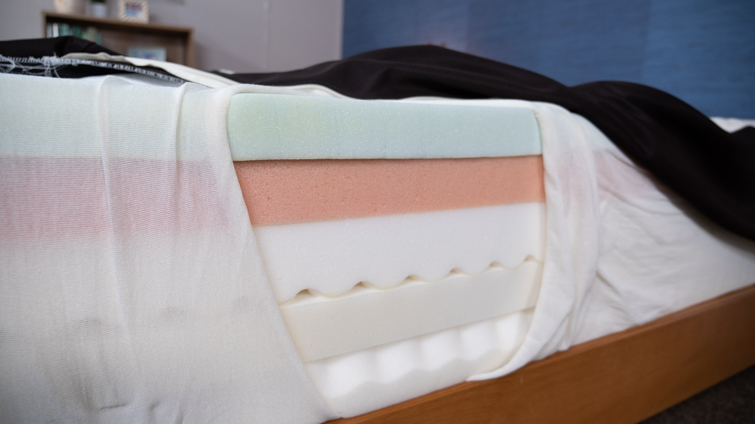
- Memory foam is a viscoelastic polyurethane that reduces motion transfer and has a slow response to pressure. As a mattress material, memory foam is best known for sinkage and contouring to the body. Memory foam mattresses come in a range of firmness options, from extra soft to extra-firm. To counteract memory foam’s tendency to retain body heat, many RV mattresses infuse this material with gel, copper, or other cooling material to improve ventilation and comfort.
- Poly foam is made from a type of polyurethane that lacks the viscoelastic properties of memory foam. Poly foam has a quick response to pressure and is typically used to complement memory foam or latex as a support or transition layer. It’s generally one of the more affordable materials used in mattresses.
- Latex foam is a natural product made from the sap of the rubber tree. A mattress made from latex will provide bounce, quick responsiveness to pressure, and cooling properties. Comfort layers made from latex can be cooler and cause less sinkage than memory foam or poly foam.
What About Hybrid Mattresses?
While most RV mattresses are all-foam and don’t contain springs, you certainly could use a hybrid mattress in some RVs. A hybrid mattress simply uses more than one material, such as coils and memory foam or coils and latex foam. Coils add lots of durability, support, and general sturdiness to a bed, but also make them heavier and more expensive. Depending on how much time you spend in your RV, the extra cost and weight may or may not be worth it.
Quality and Durability
The quality and durability of your mattress are important to consider when buying an RV mattress because they will determine how long the mattress can last as well as how well it will hold up. You may use your RV for camping, traveling, or regular commuting, but either way you want your mattress to hold up for any and all activities you use it for. We recommend looking for quality materials like strong foams, solid construction, and reliable brands to ensure that your mattress will last.
You may also want to buy from retailers that offer a warranty period. These periods can ensure that your mattress is built to last and that you can replace your mattress if something happens to it. We suggest buying from brands that offer at least a 10-year warranty.
Firmness
Firmness describes how a mattress feels when you lie down on it. A firmer mattress provides more pushback against the body and has a level sleeping surface. RV mattresses are typically thinner than traditional mattresses and may feel firmer. Plush memory foam or poly foam comfort layers can improve the cushioning of RV mattresses and make them more comfortable to those who prefer a softer sleeping surface.
Mattress firmness is rated on a 1 to 10 scale, with 1 being the softest and 10 being the firmest. We use 6.5 as the standard for medium firmness. The best firmness level for you will depend on your sleeping position, weight, and personal preferences.
In general, we recommend stomach sleepers find a softer mattress, and back and side sleepers to look for medium-firm and firmer mattresses.

How Weight Affects Perception of Firmness
Firmness is highly subjective — while we give beds a rating, we understand that rating is not the definitive firmness level, as other sleepers may experience the bed differently than we did. Weight is one factor that can affect your perception of a bed’s firmness. For example, lightweight sleepers (who weigh 130 pounds or less) tend to perceive a bed as firmer than average or heavy people, since they won’t sink into the material as much. Heavyweight sleepers (who weigh 250 pounds or more) may find beds softer than average if they sink in more, but also may find them firmer than average if they sink through the comfort layers and “bottom out” on the support layers.
Support
Firmness and support refer to different mattress characteristics. Firmness describes the degree of pushback of the mattress surface, while support refers to features that help keep the spine aligned and the neck in a neutral position. In a RV mattress, these features typically include high-density foam support layers. A supportive mattress also prevents excessive sinkage or “bottoming out” of the materials under body weight.
Heavier folks and stomach sleepers usually sleep best on a mattress with more support and firmer surface layers. Back and side sleepers are often most comfortable on a soft to medium-firm mattress that cushions their joints and helps keep the spine aligned.
Cooling
When sleeping in an RV, a priority of yours may be staying cool. Because RVs do not have the same cooling capacity as a home or apartment with an AC unit, a mattress that can stay cool may be especially important.
A lot of people also use their RVs more in the summer, when the temperature outside is warmer, so a cooling mattress may be even more important. We recommend looking for cooling materials like gel-infused foams or cooling covers.

Our thermal gun test is one of the best ways to test for cooling. We use a thermal gun that can read the temperature of a specific location and register body heat. We use this tool by having one of our expert testers measure the temperature of the mattress normally and then measure it again after laying on it for 5 to 10 minutes. We consider anything below an 8-degree difference to be good cooling, and below a six-degree difference to be great cooling.
Size
RV mattresses are typically smaller than standard mattresses to fit into more compact sleeping spaces. These mattresses may be described as “short,” meaning they have a standard width but are slightly shorter in length—typically around five inches shorter than a regular mattress. If you’re a taller person or need more room to stretch out, you may want to look for RV mattresses specifically designed with extra length for added comfort.
| RV Mattress Size | Measurements | Uses |
| RV Bunk | 28″ x 75″ 30″ x 75″ 30″ x 80″ 34″ x 75″ 35″ x 79″ | RV bunks are ideal for space-saving bunk beds in family RVs. These sizes are commonly used in areas where multiple small sleepers need to be accommodated. |
| RV Twin | 38″ x 75″ 38″ x 80″ 39″ x 75″ 40″ x 80″ | Best for single sleepers, RV twin mattresses fit in smaller spaces. Some RV bunk beds can also accommodate a twin for individual use. |
| RV Full | 53″ x 75″ 54″ x 75″ 55″ x 75″ | These mattresses are commonly used for couples or individuals who want more space. RV full mattresses are similar to standard fulls and may be preferred by those who need a bit more room than a twin. |
| RV Three-Quarter | 48″ x 75″ 48″ x 80″ | Perfect for children or tight spaces, RV three-quarter mattresses are ideal when you need a mattress that’s slightly smaller than a full, such as when two kids sleep together. |
| RV Short Queen | 60″ x 74″ 60″ x 75″ | A great option for couples in RVs, the RV short queen offers the same width as a regular queen but is slightly shorter, making it ideal for average-height sleepers in compact spaces. |
| RV Queen | 60″ x 80″ | This is the standard RV mattress for couples. RV queen mattresses offer the same dimensions as a traditional queen. It’s a popular choice for most RVs with enough space to accommodate a full-size bed. |
| RV Olympic Queen | 66″ x 80″ | Ideal for couples who want extra room, the RV Olympic queen is 6 inches wider than a standard queen, providing more space for stretching out in RVs with larger sleeping areas. |
| RV King | 72″ x 75″ 72″ x 80″ | Designed for larger RVs like motorhomes and campers, an RV king is often used by couples who want a spacious sleeping area but need a shorter length to fit the available space. |
| RV California King | 72″ x 84″ | The RV California king provides extra length (4 inches longer than an RV king) for taller sleepers and is often used by couples with a child or small family, offering ample space without overwhelming the RV. |
Thickness
RV mattresses are generally thinner than traditional mattresses, typically ranging from four to eight inches in thickness. While this can make the mattress feel less plush than a standard mattress, many RV mattresses incorporate foam materials or other comfort layers that help provide cushioning and support. Luxury RV mattresses may offer thicker options, but if space is limited, a mattress topper (ranging from one to three inches thick) can be a great option to enhance comfort. Choose a topper made from materials like foam for the best results.
Tips for Making your RV Mattress more Comfortable
Making your RV mattress comfy is important when you are using it for travel or recreation of any kind. We recommend comfortable bed sheets, mattress toppers, and quality pillows to make sure you are comfortable throughout the night and getting quality sleep even when you are not at home. This can also be important if you have long, activity-filled days that you want to be sure you are recovering from when sleeping.
Weight
While the average mattress intended for home use weighs between 50 and 150 pounds depending on size and material, the average RV mattress weighs no more than 75 pounds. This is important to consider when thinking about how you use your RV. If you are planning to move the mattress a lot into different vehicles or tents when traveling or camping, a lighter-weight mattress may be a better option. However, it is worth considering that a light mattress may also be less supportive and thinner, which may feel less comfortable.
Price
Their reduced size often means that RV mattresses cost less, but higher-end models can rival standard mattresses in terms of cost. Materials like latex that typically cost more when used in a traditional mattress can bump up the cost of an RV mattress as well. When deciding the right price point for you, considering how often you will be sleeping on the mattress is a good place to start. If you use your RV frequently, and are sleeping on it after long days of driving, camping, or outdoor activities, then a more supportive, thicker, and comfortable mattress that costs a bit more may be important for you. If you plan to use this mattress for a long time or consistently, then a more durable construction that costs more may also be a good idea.
Air Mattresses: $30–$150
RV Mattresses/Regular Mattresses: $200–$700
Camping Pads (inflatable): $75–$150
Camping Mats: $30–$50
How Much Should I Spend on an RV Mattress?
This depends entirely on what you want out of your RV mattress. We recommend setting a budget before you start shopping. This can help you ensure that you are looking within your price range. However, standard mattresses generally cost between $800 and $1,200, so this is a good price range to consider when starting your mattress hunt.
Buying Tips
Still on the fence about which RV mattress is best for you and your family? Keep these tips in mind to help demystify the shopping process.
- Know how often you’ll use it: Some folks use their RV beds only on occasion while others live in their RVs year round. The more you plan to use your mattress, the more durable and supportive it should be.
- Go with what you know: If you love the mattress you use at home, look for similar features and materials when browsing for a model for your RV.
- Shop sales: If price is a factor, shop when RV mattresses are on sale. This may be during traditional holiday mattress sales or off-season when fewer folks are outfitting their RVs.
- Grab the measuring tape: RV bedding compartments differ widely, as do RV mattresses. Make sure you know how much available space you have and the mattress size and thickness you need.
RV Camping Mattress Types
Here are the sleeping surfaces we most recommend for RV camping:
Cots: In a pinch, these sleeping surfaces can really come in handy as an extra sleeping spot for guests.
Air Mattress: If you’ve got the room, air mattresses are an RV camping option. However, we wouldn’t recommend sleeping on one if you’re sleeping in an RV for more than a few nights. RV mattresses should be far more durable than air mattresses and an ideal long-term sleeping option.
RV Mattresses: No surprise here! Of course, we recommend utilizing an RV mattress. There are a number of different models and sizes offered out there, and we suggest finding one that suits your lifestyle.
Mattress Care Guide
You’ve set up your sleeping surface and you’ve spent a night under the stars. Now what? Don’t dread the cleaning process. We’ve got you.
RV Mattresses
For RV mattresses, it’s important to keep the material in good condition even if it isn’t camping season. One of the most common issues campers run into is the trapping of moisture in the mattress.
We recommend monitoring the environment’s humidity; having the atmosphere at a low humidity can prevent mold and odor. Another way to prevent trapping moisture in the mattress is by airing out the bottom. This can be done by rotating the mattress from head to foot (only if advised by the manufacturer), or it can be done by using a mattress underlay, which should allow for sufficient airflow.
Air Mattresses
After using an air mattress while camping, there’s a high likelihood that it’s not going to be anywhere near as clean as you left it. But don’t let the outdoors discourage you. The easiest place to clean your mattress is probably going to be outside. While every air mattress is different (rely on your air mattress’s care instructions first), here a few tips if you’re in a pinch:
First, you should take care of the larger messes on the air mattresses. A lot of times, loose dirt and dust accumulates on the mattress and within crevices. We’ve found that utilizing a vacuum hose attachment or a small brush can take care of these larger particles.
Mold should be taken care of by applying a ratio of one part water and one part rubbing alcohol to the affected area. Odors can normally be tackled with a sifting of baking soda (let sit for five minutes), then a mixture of one part water and one part vinegar (gently rub on the surface).
For general cleaning purposes, mild dish soap and cold to warm water can be used to wash, not soak, an air mattress. Afterwards, we recommend drying the bed in indirect sunlight.
Camping Cot
Again, materials differ from company to company, so we suggest checking out the manufacturer’s care advice before resorting to these general rules.
When it comes to camping cots, we recommend cleaning after every camping trip and on dry days where you can care for it outdoors. Like an air mattress, you should vacuum with a hose attachment or use a small brush to take care of larger dirt and dust particles.
You may use cold water only to clean the surface, or you can add mild soap or detergent for super dirty areas of the cot. A scrubbing brush may be used gently on tougher spots. The cot’s frame, however, can be cleaned with disinfectant wipes.
Once the cleaning process is over, it’s best to dry away from direct sunlight.
Camping Mat and Pads
For loose dirt and dust, you can use small brush or vacuum hose. We recommend cleaning with water, mild dish soap, and a cloth. For inflatable camping pads, it’s best to keep the valves shut to prevent water from entering the interior of the pad.
When finished, we recommend drying indirect sunlight. For inflatable pads, leave the valves open to keep the interior from gathering any moisture. We also suggest leaving the valves open when you store it and keeping it in a cooler place until the next time you need it.
RV Mattress Frequently Asked Questions
What sizes are available for RV mattresses?
Although they often have the same size names as standard mattresses (twin, queen, king, etc.), RV mattresses tend to have slightly different dimensions — usually shorter and/or narrower. And even within RV sizes, there may be some slight variation. For instance, the Dreamfoam Essential has three different RV king sizes (70 inches by 74 inches, 70 inches by 80 inches, and 72 inches by 80 inches). Then there are several different RV bunk sizes, short queen, short king, and so on. So the short answer is, there are many different RV mattress sizes, depending on the bed.
Can you use a standard-sized mattress in an RV?
Possibly! Every vehicle is different, so you’ll want to measure the dimensions of all of the beds in your RV before making a purchase. While there’s a good chance that a standard full, twin, queen, or king could fit in your RV, there’s also a chance you’ll need an RV-specific size.
Can you use a mattress topper on an RV mattress?
Absolutely! A topper can help adjust the firmness of an RV mattress and give it some added height. Once again, make sure you’re getting something that can accommodate the often unique dimensions of an RV mattress.
What’s the proper way to care for an RV mattress?
In terms of construction and materials, RV mattresses aren’t all that different from regular mattresses. The biggest difference comes from the size and the environment that the mattress is kept in, as RVs tend to have less ventilation than a regular bedroom. To make matters worse, many sleeping platforms in RVs don’t have as much room for airflow as a standard box spring or platform bed. This makes it easier for mold to form, which you can prevent by 1) putting a dehumidifier in the RV, 2) keeping the windows of the vehicle open when you can, and 3) storing the mattress on an elevated platform when you’re not using it — either inside the vehicle or somewhere else.
What size mattress fits in a semi truck?
There’s a bit of variability here, but most semi truck mattresses have an 80” length and 40” width. Of course, this can change depending on the bed or space available, but this is the typical size.
How can you prevent mold under an RV mattress?
It’s important to allow air circulation to prevent mold buildup under your RV mattress. Using a mattress topper, or piece of cardboard, or adding a moisture barrier like mattress underlay can help prevent moisture from accumulating.
How thick should a RV mattress be?
RV mattresses typically range from 4 to 8 inches thick, with 5 to 6 inches being the most common. This thickness is practical for RVs, as these mattresses need to be lightweight, flexible, and fit well in confined spaces.
How We Chose These Mattresses
Our team of Certified Sleep Science Coaches has reviewed more than 300 products in our mattress lab, running each one through tests such as pressure-mapping and measuring motion transfer with a seismometer. From there, we give each bed an overall score based on materials, comfort, support, cooling, and edge support. We also factor in brand performance with categories such as value and warranty. Click here to learn more about our methodology.
Best RV Mattresses 2025
| Mattress | Best For | Price (Queen) | Coupon | Review |
| Brooklyn Bedding Signature Hybrid | Overall | $1,332 | Brooklyn Bedding Coupon | Read Our Review |
| Dreamfoam Essential | Value | $524 | Brooklyn Bedding Coupon | Read Our Review |
| Brooklyn Bedding Aurora Luxe | Luxury | $2,265 | Brooklyn Bedding Coupon | Read Our Review |
| Dreamfoam Hybrid | Queen | $799 | Brooklyn Bedding Coupon | Read Our Review |
| Helix Midnight | Cooling | $1,373 | Helix Coupon | Read Our Review |
| Plank Firm | Firm | $1,332 | Brooklyn Bedding Coupon | Read Our Review |

Logan Block
Former Content Director
About Author
Logan is the former content director of Sleepopolis. As content director, he reviewed new mattresses every week and curated the comparisons, best of pages, and video guides on the site. Logan perfected his method by personally testing over 200 different mattresses, so he’s not only able to discern the overall vibe of a specific bed, but to contextualize its feel within the bed-in-a-box market as a whole.
Back Sleeper










